- Yokohama-shi Top Page
- Municipal Government Information
- Public Relations, Public Information, News
- Publications and publications
- Public Relations Printed Materials
- Public information Yokohama
- Public information Yokohama-shi version
- Discover Yokohama Aya
- June 2023 issue Let's get acquainted with Yokohama Port at Yokohama Minato Museum!
Here's the text.
June 2023 issue Let's get acquainted with Yokohama Port at Yokohama Minato Museum!
Yokohama with sea, port, greenery, history, region, people and various attractions. We will deliver the color of this city as "Yokohama Aya Discovery". This time, from the Yokohama Minato Museum (Minamirai, Nishi-ku).
Last Updated July 4, 2023
Please see the link for the contents of the "Public Information Yokohama" June 2023 issue "Yokohama Aya Discovery".
Let's get acquainted with Yokohama Port at Yokohama Minato Museum!
What is the Yokohama Minato Museum?
Michiko Shimamune, Deputy Director of Arts and Sciences, Yokohama Minato Museum
The Yokohama Minato Museum (outside site) conducts research and research on Yokohama Port, collects and preserves materials and books, exhibits and releases, and educational activities with the main theme of "Yokohama Port in History and Life". The museum opened in 1989 under the name "Yokohama Maritime Museum" in 1989 and renamed the current building along with the renewal in 2009 (Heisei 21), and opened in June 2022. We aim to be a museum where many people can learn, think and enjoy Yokohama Port more.
Introduction of ship model
In the permanent exhibition room of the museum, models of ships that were active in Yokohama in each era are displayed, centering on the "History Zone of Yokohama Port", which looks back on seven eras from the opening of the port to the present day. The charm of a ship model is that you can see the whole from the bottom of a huge ship to decks and chimneys. Why don't you see the elaborately reproduced beautiful figure up close and think about the times when each ship ran around the world from Yokohama?
(1)Tenmaru
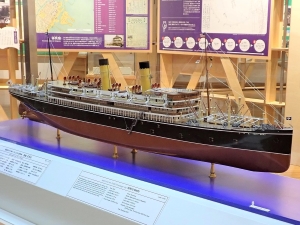
It is a passenger ship built in 1908 (Meiji 41), with a total of 13,454 tons. At the end of the Meiji era, this is the first large luxury passenger ship built at Mitsubishi Nagasaki Shipyard, exceeding 10,000 tons in Japan, against the U.S.-English passenger ship that competed on the Pacific crossing route. The shipowner was an Orient steamship led by Soichiro Asano, also known as the "father of the Keihin Industrial Zone", and served regular routes from Hong Kong to Yokohama to Hawaii to San Francisco. A company flag is raised on the bow of the ship, but the Taiyo Maru model also has the Orient Kisen flag. The design is based on the fan of the Asano family crest. [Scale = 1/100]
(2)Andre rubon
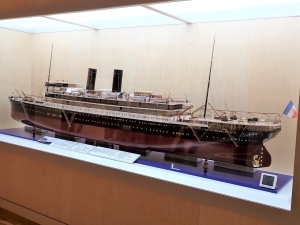
It is a passenger liner built in 1915 (Daisho 4), with a total of 13,682 tons. The owner of the ship was Mesa Juri Mali Tim in France, which was on a regular route from Marseille to via Suez to Yokohama. During the Great Kanto Earthquake of 1923, he was anchored at Yokohama Port and rescued a large number of survivors along with other ships. This year (2023) was 100 years after the Great Kanto Earthquake. From the end of August, the museum will hold a special exhibition "The Great Kanto Earthquake 100 Years from Ships and Ports". We will also introduce trends in ships engaged in rescue. [Scale = 1/48]
(3)A circle
It is a passenger liner built in 1929 (Showa 4), with a total of 9,625 tons. In the long-term recession of World War I, the number of Brazilian immigrants increased rapidly. Osaka Merchant ship built the ship and its sister ship Riodejiya Nero Maru for South American route and carried a large number of immigrants to Brazil. The ship's third-class passenger (migrant) capacity of 1,076 is the largest Japanese immigrant ship until then. This model is larger than 3 meters long. If you combine the deck of the model with your eyes, you can also see the onboard furnishings (chairs, tables, etc.) installed in some parts, and feel like you have entered the ship? You can enjoy it. [Scale = 1/48 Mitsui O.S.K. Lines Ltd.]
(4)Chichibu Maru Chichibumaru)
A passenger ship built in 1930 (Showa 5). 17,498 total tons. It is the largest Japanese passenger ship before the war, built in the Yokohama culvert where the hotel is currently located. We have entered service on the San Francisco route of Nippon Yusen. It was praised as the "queen of the Pacific" for its first-class interior, furniture, and shipper service. The first-class veranda at the rear of Chichibu Maru was designed and manufactured by the Yokohama culvert in the Middle Ages (Kamakura period) style, and Koma was installed in the center of the veranda. There is also a guardian dog on the model, so be sure to find it. [Scale = 1/100]
(5)Barge
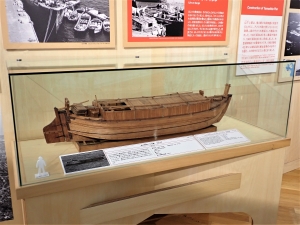
The barge was the leading role in port freight transportation until container ships appeared in the late 1960s. Carry cargo between warehouses, sheds, factories and berths in the harbor and ships berthing. There were two types that were towed on the pulling boat and those that were self-propelled. During the period of high economic growth, the trade volume at Yokohama Port surged. At this time, a large amount of barges were built, and they were very active in freight transportation. Some families lived in barges, and there was a boarding school for children in the city. [Scale = 1/20]
(6)Kororado Maru
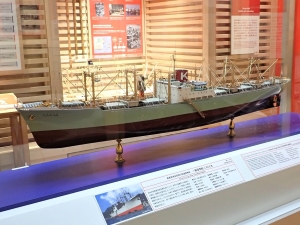
This is a general cargo ship of Kawasaki Kisen built in 1960 (Showa 35), with a total of 10,105 tons. Before containerships became the mainstream of world shipping, general cargo ships with cranes on these ships were active all over the world, and loading and unloading of cargo was basically done by human power. Tools for loading and unloading cargo (called tools) were devised according to the shape and size of the cargo. Near the roll model, real tools used by the cargo handling company in Yokohama Port until about 50 years ago are displayed. [Scale = 1/100 Kawasaki Kisen Kaisha, Ltd.]
(7)Kyomaru Tou Tokyomaru)
The Kyomaru Azuma, built in 1966 (Showa 41) at the Ishikawajima Harima Heavy Industries Yokohama Plant, was the world's largest 150,000-ton tanker at the time of construction. In the 1940s and 1940s, orders for large tankers and bulk carriers increased from foreign countries, and many ships for export were built in Japan. Shipyards in Yokohama also expanded their facilities and built ships one after another. [Scale = 1/100]
(8)Hikawamaru Hikawamaru)
Nippon Yusen's Seattle route was built on the Yokohama culvert in 1930 (Showa 5), with 11,622 total tons. After the war, he escaped the war of the Pacific War and returned to the Seattle route. On the anniversary of the opening of Yokohama Port on June 2, 1961, the ship was opened in front of Yamashita Park, and was designated as a National Important Cultural Property in 2016. At the beginning of the release, the color of the hull was emerald green. Hikawa Maru's color photographs and Ryohei Yanagihara Art Museum's poster include Hikawa Maru, which is painted in a different color than the hull-color model at the time of active duty. Please look for it. [Scale = 1/100]
(9)Diamond princess
This is a large cruise liner built at the Nagasaki Shipyard of Mitsubishi Heavy Industries in 2004, with 115,875 tons. It is operated by Princess Cruises in the United States. This is the first ship that arrived at Yokohama on May 10, 2013, and arrived at the Shinko Wharf Passenger Ship Terminal, which opened in October 2019. On March 10, 2023 (Reiwa 5), we entered Yokohama as the first foreign cruise ship after Corona. There are plenty of onboard facilities and activities for Japanese people, such as large baths, and you can see many pools on the deck of the model. Let's look for it. [Scale = 1/150, Yokohama City Collection]
(10)Sail Training Ship, Nippon Maru
A training sailing ship built in 1930 (Showa 5), 2,278 total tons. This is a model of Sail Training Ship, Nippon Maru across the hotel. A training sailing ship is a sailing ship that trains ship staff. Until he retired in 1984, Sail Training Ship, Nippon Maru had raised 11,500 trainees. It was designated as a national important cultural property in 2017. In this museum, two models of Nippon Maru are on display, sailing and not stretching. [Scale = 1/75]
Permanent exhibition
In the `` History Zone of Yokohama Port '' where ship models are displayed, from the days of Yoshidashinden and Yokohamamura before the opening of the port, Perry arrived, Osanbashi construction, golden age of passenger ships, Yokohama Port during and after the war, container ships It introduces the appearance and history of about 160 years to the present day. In the Yokohama Port Rediscover Zone, you can learn about the wharf of Yokohama Port, the training of seafarers with Sail Training Ship, Nippon Maru, and exchanges with sister ports, friendship ports and trade cooperation ports. In addition, there is also a VR (virtual reality) theater "Minato Capsule" where you can experience the history of Sail Training Ship, Nippon Maru and the sailing exhibition with powerful large images, and an exhibition room for "Technology and History of Landfill and Port Construction" that introduces Yokohama's landfill from the development of Nitta in the Edo period to the construction of the current Shinhonmoku Wharf.
[Reception end] Reader present
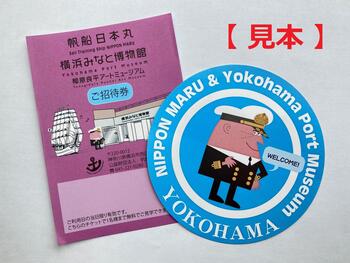
The application has been closed and prizes have been sent to the winners on Tuesday, July 4th. Thank you very much for your application.
Thank you for always seeing "Public Information Yokohama" and "Yokohama Aya Discovery". A set of invitation tickets common to Yokohama Minato Museum and Sail Training Ship, Nippon Maru and original stickers will be presented to 5 groups of 10 people by lottery from those who received their impressions. If you wish, please refer to the following six items. ※Please specify and apply by postcard (to Yokohama City Hall Policy Bureau Public Relations Section, 6-50-10 Honcho, Naka-ku, Yokohama 231-0005) or e-mail (sss-saihakken@city.yokohama.jp). The deadline must arrive on Friday, June 30, 2023.
※ 1.Postal code, 2. Address, 3. Name, 4. Impression, 5. I would like to read, 6. "I wish to present the June issue"
The winner's announcement will be returned by sending the prize. In addition, the personal information you receive will not be used for any purpose other than sending prizes.
Contact Yokohama City Hall Policy Bureau Public Relations Section TEL: 045‐671-2331 FAX: 045‐661-2351
Inquiries to this page
Telephone: 045-221-0280
Telephone: 045-221-0280
Fax: 045-221-0277
Page ID: 447-406-938







